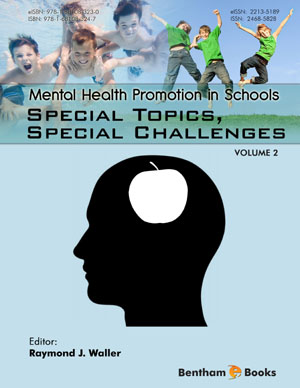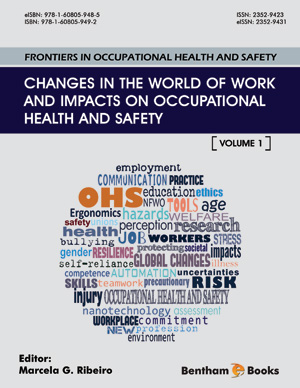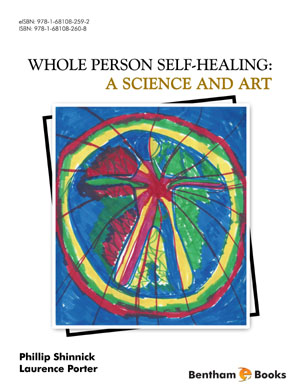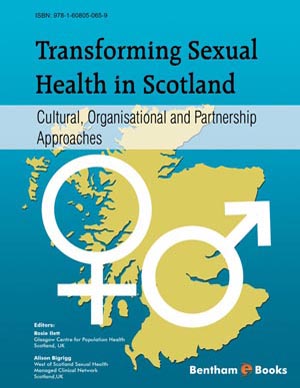Book Volume 2
Restorative Justice and Transdisciplinary Praxis: An Investigation in Ontario Schools and a Framework for Moving Forward in School Mental Health Promotion
Page: 3-29 (27)
Author: S. A. Moore and R. C. Mitchell
DOI: 10.2174/9781681083230116020005
PDF Price: $15
Abstract
Schools are, for many nations, among the most enduring societal institutions. As such, they serve as repositories of wisdom, learning, and tradition. Tradition can be of incalculable cultural value, but can also serve as a functional barrier in some cases. Promotion of mental health in schools is a violation of traditional thought for many. This chapter discusses transdisciplinary praxis as a functional framework within which needs of contemporary students can be effectively addressed. This framework involves abandonment of the punitive practices, exclusion, and deficiency based assessment traditional in many schools and in juvenile justice in favour of restorative justice, community building, and considering behaviour within environmental context. Restorative practices have garnered such support so rapidly that some leading universities now offer graduate degrees in their study and implementation.
Students with Disabilities: Reversing a History of School as a Risk to Mental Health
Page: 30-60 (31)
Author: Sheryl R. Matney and Joel P. Willis
DOI: 10.2174/9781681083230116020006
PDF Price: $15
Abstract
Persons with disabilities have, throughout history, been exposed to segregation, harassment, and brutal maltreatment. Few opportunities existed whereby meaningful community involvement was a viable option. Over the course of centuries, little changed for far too many. Legislation rapidly snowballed over the past hundred years, decreasing persecution and, even more recently promoting individual rights and access rather than minimizing mistreatment. School legislation and compulsory education have arguably had more impact on improving outcomes for youth with disabilities than any other political or social realm, and have recently moved from the older philosophy of mainstreaming to the current model of inclusion. This reflects a significant improvement, but has to be fully implemented in vivo or in vitro.
Children’s Temperament at School and in the Classroom
Page: 61-103 (43)
Author: Kathleen Moritz Rudasill, Kate Sirota, Mary Kralemann, Amanda Prokasky, Kenji Madison and Victoria J. Molfese
DOI: 10.2174/9781681083230116020007
PDF Price: $15
Abstract
Temperament is arguably one of the most important childhood traits about which educators should be thoroughly versed. Childhood temperament is linked with, among other outcomes, three that are essential to school success: behavioral responses, academic performance, and social interaction. It also plays a compelling role in longterm mental health. This chapter describes the range of temperamental manifestations and offers suggestions for promoting temperamental factors to support resilience rather than foster risk.
Adolescent Pregnancy: Rejecting Preference via ‘Profiles in Courage’ in Policy and Practice
Page: 104-130 (27)
Author: Kimberly M. Wickersham, Raymond J. Waller, Suzanne Tew-Washburn and Sherrionda H. Crawford
DOI: 10.2174/9781681083230116020008
PDF Price: $15
Abstract
Ideally, best practice methods are built upon an edifice of informed policy guided by the low star of serving student best interests. Unfortunately, such a stalwart foundation is non-existent for many psychosocial and educational initiatives. In fact, it is lamentably common for policy to be constructed on a sand dune comprised of presumption, special interests, or intuition. Unfortunately, innumerable examples exist to warn us that human behavior is frequently counterintuitive, increasing the risk of policy decisions guided by presumption or face validity. While abstinence-only efforts to reduce adolescent pregnancy and associated adverse outcomes sometimes occurring as a result of high risk sexual behavior might have initially been defended as plausible, the evidence is compelling that such efforts are ineffective compared with other methods. Pregnancy and risk reduction policy and practice supported by empirical inquiry are discussed, and this issue is presented as an example actually and conceptually representative of divergence of public policy from the body of scientific knowledge.
Creating Safer Environments for Lesbian, Gay, Bisexual, and Transgender (LGBT) Youth and Families: Opportunities for School Mental Health Promotion
Page: 131-155 (25)
Author: Carly A. Scarton and Elizabeth A. Mellin
DOI: 10.2174/9781681083230116020009
PDF Price: $15
Abstract
As schools reflect the sociopolitical climate of the country, educators and school mental health professionals are increasingly attending to the school climate for lesbian, gay, bisexual, a nd transgender (LGBT) youth as well as children raised in LGBT-headed households. This chapter provides school mental health professionals and educators with a summary of LGBT issues common in school settings as well as concomitant impacts on the mental health of LGBT students and families. Lastly, this chapter offers pragmatic thoughts for creating safer school environments that promote mental health for all students.
Student Athletics: Opportunity, Challenge, and the Byzantine Construct ‘Body Image’
Page: 156-177 (22)
Author: John J. Miller
DOI: 10.2174/9781681083230116020010
PDF Price: $15
Abstract
Student interscholastic sport involvement is often presumed to be a protective factor for participating athletes, and this is no doubt the case for some. This protection derives from influences such as extra privileges, adoration, popularity, and beliefs about future prospects. However, student athletic participation can be a significant risk for others. Risk occurs as a result of significant pressures for low body weight, ideal physique, and coaching methods used. These pressures are different based on gender, and even based on sport of preference. This chapter describes student athletes as a potentially vulnerable population and discusses the risks that can be experienced using the example of increased incidence of eating disorders.
Students Coping with Chronic Physical Conditions
Page: 177-209 (33)
Author: Laura L. Myers and Allison M. Wiman
DOI: 10.2174/9781681083230116020011
PDF Price: $15
Abstract
Students with chronic physical conditions may experience substantial risk of undesirable outcomes in school. The experience of physical challenges may synergistically affect mental health and school performance. School personnel and families may experience additional stress meeting the needs of students for whom the expertise or resources necessary for care provision is insufficient. Information, support, and effective programming can result in a more desirable outcome for everyone. While often considered synonymous with disability, these are distinct issues.
A Review of Sexual Exploitation Risk Factors for Our Children and Ways to Create Positive Classroom and Community Environments
Page: 210-238 (29)
Author: Denise M. Green, Sarah E. Twill and Rebecca Fensler
DOI: 10.2174/9781681083230116020012
PDF Price: $15
Abstract
All families experience some degree of discord. When that discord becomes severe and synergistically mediated by environmental challenges such as low performance and disconnectedness at school, students may experience behavioral and psychosocial risks associated too commonly with highly undesirable outcomes. Among the most dangerous example is that students can become targets of recruiters of prostitution by human traffickers, who are often amazingly adept at exploiting the physiological and psychosocial needs of children and adolescents for nurturance and attachment in numerous ways. Predators can immerse disaffected youth into networks so convoluted that recovery is difficult, if not impossible. Engagement with the juvenile justice system is another undesirable outcome for those youth who disaffiliate from peers, family, and the school community, whether by choice, manipulation, or both. Considering the severity of the potential consequences, it is incumbent upon schools to play an assertive role in promoting resilience, connectedness, and engagement in school community membership and fostering school success.
Adopted Children in Schools: A Guide for Educators
Page: 238-257 (20)
Author: M. Elizabeth Vonk and Katherine N. King
DOI: 10.2174/9781681083230116020013
PDF Price: $15
Abstract
Similar to a previous discussion on student athletic participation, adoption is often postulated to be an overwhelmingly protective event. Even more so than in that example, the assumption is, in the following example, likely true. Children who have been adopted do well in many domains of life. Even so, adoption can convey risk to children depending on several factors that are discussed below such as the type of adoption process a child experiences, providing many opportunities for schools to be involved in mental health promotion. Moreover, school practices can convey risk to adopted children, depending on the approach and sensitivity used in presentation. This chapter also, therefore, provides specific examples of how common school exercises that may convey risk can, often with little resource investment, encourage adopted children and facilitate their participation as members of the school community.
The Clinically Anxious Student: Evidence-based Approaches to Assessment and Treatment
Page: 258-281 (24)
Author: Stephanie Grace Prost and Bruce A. Thyer
DOI: 10.2174/9781681083230116020014
PDF Price: $15
Abstract
Although the primary focus of this text is not to provide a reference on mental illness conditions (see preface), this chapter is included for several reasons. First, anxiety disorders are the most common psychosocial diagnoses worldwide, making it a virtual certainty that anyone in the education profession will work with affected students during their career. Second, this chapter provides a foundation that will facilitate appreciation of the content in the succeeding chapter. Third, much of this material links to other chapters herein, and hopefully enhances the understanding that the information throughout the text is intimately and irrevocably interrelated. The psychosocial conditions described can impact individuals along a continuum ranging from impairing to life threatening. Following this discussion is a chapter discussing the intricacies-and necessity-of intervening in the school setting with an anxiety disorder largely unknown, yet not rare.
Social Anxiety Disorder in Schools: The Example of Paruresis
Page: 282-305 (24)
Author: Steven Soifer and Wendi Albert
DOI: 10.2174/9781681083230116020015
PDF Price: $15
Abstract
Anxiety disorders affect more members of the global community that any other psychosocial phenomena. Their voluminous impact is not limited to adults; anxiety disorders substantially influence the quality of life of many children and adolescents as well. This chapter diverges in format and intent from previous chapters in that the goal herein is to provide the reader with some of the applied difficulties that can emerge when attempting to intervene in the school setting. This chapter is not built upon the weight of empirical inquiry that defined previous chapters—indeed, that weight of evidence does not exist for the following topic. In order that the reader can appreciate the functional impairment that can be associated with anxiety disorders, a discussion of one type social anxiety disorder is reviewed. Then, in an attempt to illustrate the school effects related to what is perhaps the most common anxiety disorder most have never heard of paruresis and how it results in considerable distress as well as significant intervention challenges. The reader is strongly encouraged to exercise imaginative projection into the complications associated with this disorder in the school environment. Finally, a treatment protocol developed by the senior author is presented for the purpose of conveying the importance of school involvement.
Reversing the Outcomes for US Military Families: From Resilience to Risk during a Protracted Armed Conflict
Page: 306-330 (25)
Author: Amy E. Cox and Raymond J. Waller
DOI: 10.2174/9781681083230116020016
PDF Price: $15
Abstract
Historically, US military families have shown themselves resilient against numerous risk factors of potentially significant consequence. However, involvement in the longest armed conflict in US historyoften referred to as the war on terror-and concurrent policy changes for service members-has eroded the protection of resiliency for many military families. This chapter concludes the text by discussing these changes, the effects observed on contemporary military families, and confers important considerations for school mental health promotion for the huge student demographic from a military family. A brief summary of this volume is also provided.
Introduction
This second volume in the book series gives clear explanations of some special topics and challenges related to the roles of the school in adolescent mental healthcare (such as disability, temperament, psychological resilience, school safety and LGBT issues). Each chapter addresses beneficial and detrimental practices that schools and any involved professionals may engage in. Key features of this volume include: 1) a multidisciplinary approach to mental healthcare provision in school settings, 2) a discussion of school-based intervention in each chapter and 3) the incorporation of DSM-V standards in discussions of diagnostic criteria where applicable. This volume serves as a reference work for all educational and mental health professionals (teachers, administrators, psychologists, social workers, nurses, counselors) interested in the promotion of mental health and risk management in schools.












